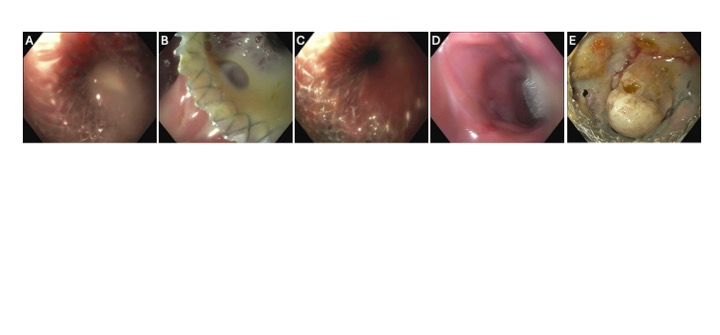Sunday Poster Session
Category: Interventional Endoscopy
P1467 - Use of Lumen-Apposing Metal Stents to Treat Tubo-Ovarian Abscesses
Sunday, October 26, 2025
3:30 PM - 7:00 PM PDT
Location: Exhibit Hall

Lakshmi Mahajan, MD (she/her/hers)
Columbia University Irving Medical Center
New York, NY
Presenting Author(s)
Award: ACG Presidential Poster Award
Lakshmi Mahajan, MD1, Nicholas Costable, MD2, Sammy Ho, MD, FACG2
1Columbia University Irving Medical Center, New York, NY; 2Montefiore Medical Center, Bronx, NY
Introduction: Lumen-apposing metal stents (LAMS) were originally designed for transmural drainage of peripancreatic fluid collections. They are now increasingly utilized for numerous minimally invasive procedures as an alternative to surgical or percutaneous interventions. Tubo-ovarian abscesses, manifestations of pelvic inflammatory disease, that cannot be medically managed have historically required surgical or percutaneous intervention. At our academic medical center, we identified patients with tubo-ovarian abscesses for whom surgical and percutaneous procedures were contraindicated. In these cases, we designed and applied a novel method using LAMS for abscess drainage. Patients’ hospital course and outcomes compared to traditional treatment methods were analyzed.
Case Description/
Methods: Five female patients, ranging in age from 27 to 79 years old were identified. Each patient had clinical findings (abdominal pain, nausea, vomiting, and fever), leukocytosis, and computed tomography imaging suggestive of a tubo-ovarian abscess for which standard medical management would be ineffective. In each patient, Interventional Radiology could not find an adequate window allowing for percutaneous drainage. Our team performed lower endoscopic ultrasounds which revealed fluid collections of 3, 3, 6, 7, and 6 centimeters in each patient. We then successfully performed lower endoscopic ultrasound-guided transluminal drainage of these abscesses via short-term placement of a LAMS into the rectum. Purulent material draining from the stents was observed immediately after placement. Stents were removed after complete drainage of fluid collections. Total dwell time of the stents in each patient was 10, 16, 6, 24, and 4 days, respectively. Total length of hospital stay was 12, 22, 12, 7, and 8 days, respectively.
Discussion: Analysis of outcomes after our procedure showed that all patients’ clinical conditions improved with no further complications, leukocytosis resolved, and total drainage of abscesses was achieved. Compared to conventional invasive interventions, this procedure reduces patient pain and discomfort, infection risk, and incomplete drainage risk. It also preserves fertility, has higher success rates, and allows for shorter hospital stays and quicker recovery. We have established how transrectal drainage of tubo-ovarian abscesses using endosonographically placed LAMS is a safe and effective technique and should be considered a primary alternative to surgical or percutaneous interventions.

Figure: Figure 1:
A. Endoscopic image captured during lower EUS of patient 1 showing a 15mm x 10mm Axios stent in rectosigmoid colon draining purulent material.
B. Endoscopic image captured during lower EUS of patient 2 showing an 8mm x 8mm Axios stent in colon draining purulent material.
C. Endoscopic image captured during lower EUS of patient 3 showing a 15mm x 10mm Axios stent in rectum draining purulent material.
D. Endoscopic image captured during lower EUS of patient 4 showing a 10mm x 10mm Axios stent in sigmoid colon draining purulent material.
E. Endoscopic image captured during lower EUS of patient 5 showing a 10mm x 10mm Axios stent in rectum with surrounding purulent material and granulation tissue.
Disclosures:
Lakshmi Mahajan indicated no relevant financial relationships.
Nicholas Costable indicated no relevant financial relationships.
Sammy Ho indicated no relevant financial relationships.
Lakshmi Mahajan, MD1, Nicholas Costable, MD2, Sammy Ho, MD, FACG2. P1467 - Use of Lumen-Apposing Metal Stents to Treat Tubo-Ovarian Abscesses, ACG 2025 Annual Scientific Meeting Abstracts. Phoenix, AZ: American College of Gastroenterology.
Lakshmi Mahajan, MD1, Nicholas Costable, MD2, Sammy Ho, MD, FACG2
1Columbia University Irving Medical Center, New York, NY; 2Montefiore Medical Center, Bronx, NY
Introduction: Lumen-apposing metal stents (LAMS) were originally designed for transmural drainage of peripancreatic fluid collections. They are now increasingly utilized for numerous minimally invasive procedures as an alternative to surgical or percutaneous interventions. Tubo-ovarian abscesses, manifestations of pelvic inflammatory disease, that cannot be medically managed have historically required surgical or percutaneous intervention. At our academic medical center, we identified patients with tubo-ovarian abscesses for whom surgical and percutaneous procedures were contraindicated. In these cases, we designed and applied a novel method using LAMS for abscess drainage. Patients’ hospital course and outcomes compared to traditional treatment methods were analyzed.
Case Description/
Methods: Five female patients, ranging in age from 27 to 79 years old were identified. Each patient had clinical findings (abdominal pain, nausea, vomiting, and fever), leukocytosis, and computed tomography imaging suggestive of a tubo-ovarian abscess for which standard medical management would be ineffective. In each patient, Interventional Radiology could not find an adequate window allowing for percutaneous drainage. Our team performed lower endoscopic ultrasounds which revealed fluid collections of 3, 3, 6, 7, and 6 centimeters in each patient. We then successfully performed lower endoscopic ultrasound-guided transluminal drainage of these abscesses via short-term placement of a LAMS into the rectum. Purulent material draining from the stents was observed immediately after placement. Stents were removed after complete drainage of fluid collections. Total dwell time of the stents in each patient was 10, 16, 6, 24, and 4 days, respectively. Total length of hospital stay was 12, 22, 12, 7, and 8 days, respectively.
Discussion: Analysis of outcomes after our procedure showed that all patients’ clinical conditions improved with no further complications, leukocytosis resolved, and total drainage of abscesses was achieved. Compared to conventional invasive interventions, this procedure reduces patient pain and discomfort, infection risk, and incomplete drainage risk. It also preserves fertility, has higher success rates, and allows for shorter hospital stays and quicker recovery. We have established how transrectal drainage of tubo-ovarian abscesses using endosonographically placed LAMS is a safe and effective technique and should be considered a primary alternative to surgical or percutaneous interventions.

Figure: Figure 1:
A. Endoscopic image captured during lower EUS of patient 1 showing a 15mm x 10mm Axios stent in rectosigmoid colon draining purulent material.
B. Endoscopic image captured during lower EUS of patient 2 showing an 8mm x 8mm Axios stent in colon draining purulent material.
C. Endoscopic image captured during lower EUS of patient 3 showing a 15mm x 10mm Axios stent in rectum draining purulent material.
D. Endoscopic image captured during lower EUS of patient 4 showing a 10mm x 10mm Axios stent in sigmoid colon draining purulent material.
E. Endoscopic image captured during lower EUS of patient 5 showing a 10mm x 10mm Axios stent in rectum with surrounding purulent material and granulation tissue.
Disclosures:
Lakshmi Mahajan indicated no relevant financial relationships.
Nicholas Costable indicated no relevant financial relationships.
Sammy Ho indicated no relevant financial relationships.
Lakshmi Mahajan, MD1, Nicholas Costable, MD2, Sammy Ho, MD, FACG2. P1467 - Use of Lumen-Apposing Metal Stents to Treat Tubo-Ovarian Abscesses, ACG 2025 Annual Scientific Meeting Abstracts. Phoenix, AZ: American College of Gastroenterology.

